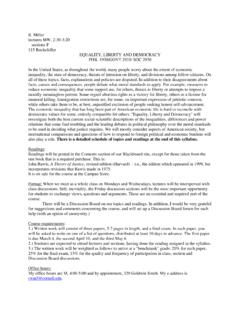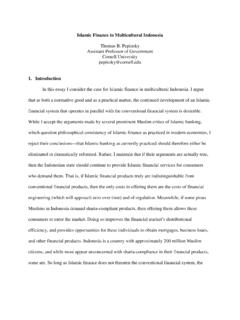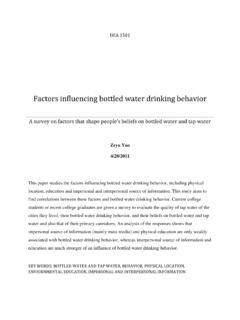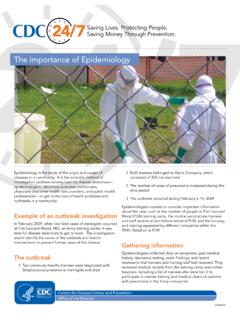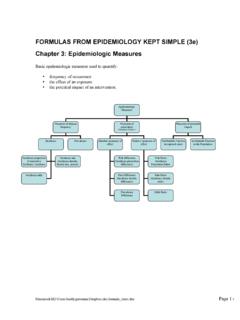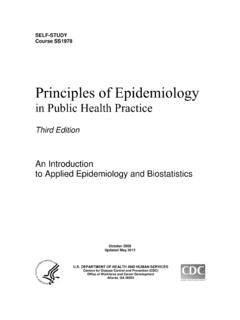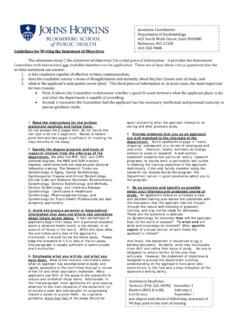Transcription of Glossary of Epidemiology Terms - Cornell University
1 Glossary of Epidemiological Terms A ACCURACY and PRECISION. Accuracy is the extent to which a measurement reflects the true value. It is the tendency of test measurement to center around the true value. "Precise" means sharply defined or measured. Data can be very precise, but inaccurate. It would be precise but inaccurate to say that a meter equals inches. It would actually be more accurate to say that a meter equals a little over one yard, although that may not sound as impressive. An accurate measurement is one that is very close to the true value of the phenomenon we are observing. A precise measurement is one that has very little scatter: Repeat measurements give more or less the same value. If the measured data have high precision but poor accuracy, one may suspect that a systematic bias has been introduced, , we are using an instrument where the zero position has not been set properly.
2 If we do not know the expected value of a phenomenon but are trying to determine just that, it is obviously better to have accurate observations with poor precision than very precise, but inaccurate values, since the former will give a correct, but imprecise estimate while the latter will give a wrong, but very precise result. Figure : Precision is a measure of repeatability while accuracy refers to how close the average value is to the ``true'' value. ACUTE CONDITION. A type of illness or injury that ordinarily lasts less than 3 months, was first noticed less than 3 months before the reference data of the interview, and was serious enough to have had an impact on behavior. (Pregnancy is also considered to be an acute condition despite lasting longer than 3 months). AGE ADJUSTMENT, DIRECT METHOD. The application of age-specific rates in a population of interest to a standardized age distribution in order to eliminate differences in observed rates that result from age differences in population composition.
3 This adjustment is usually done when comparing two or more populations at one point in time or one population at two or more points in time. Age-adjusted rates are calculated by the direct method as follows: AGENT. A factor, such as a microorganism, chemical substance, or form of radiation, whose presence, excessive presence, or (in deficiency diseases) relative absence is essential for the occurrence of a disease. AGE-SPECIFIC RATE. A rate limited to a particular age group. The numerator is the number of occurrences in that age group; the denominator is the number of persons in that age group in the population. AIRBORNE TRANSMISSION Airborne transmission refers to situations where droplet nuclei (residue from evaporated droplets) or dust particles containing microorganisms can remain suspended in air for long periods of time.
4 These organisms must be capable of surviving for long periods of time outside the body and must be resistant to drying. Airborne transmission allows organisms to enter the upper and lower respiratory tracts. Fortunately, only a limited number of diseases are capable of airborne transmission. Diseases capable of airborne transmission include: Influenza, Whooping cough, Pneumonia, Tuberculosis, Polio AMBULATORY CARE. Health care provided to persons without their admission to a health facility. Ambulatory care is medical care, including diagnosis, observation, treatment and rehabilitation, provided on an outpatient basis. Ambulatory care is given to persons who are not confined to a hospital but rather are ambulatory and, literally, are able to ambulate or walk about. A well-baby visit is considered ambulatory care even though the baby is not walking.
5 ANALYTIC Epidemiology . The aspect of Epidemiology concerned with the search for health-related causes and effects. Uses comparison groups, which provide baseline data, to quantify the association between exposures and outcomes, and test hypotheses about causal relationships. ANALYTIC STUDY. A comparative study intended to identify and quantify associations, test hypotheses, and identify causes. Two common types are cohort study and case-control study. ASSOCIATION. Statistical relationship between two or more events, characteristics, or other variables. ATTACK RATE. The percentage of ill persons out of all persons reporting a risk behavior. It is a variant of an incident rate, applied to a narrowly defined population observed for a limited period of time, such as during an epidemic. ATTRIBUTABLE PROPORTION.
6 A measure of the public health impact of a causative factor; proportion of a disease in a group that is exposed to a particular factor which can be attributed to their exposure to that factor. AVERAGE LENGTH OF STAY. The average length of stay per discharged patient is computed by dividing the total number of hospital days for a specified group by the total number of discharges for that group. B BAR CHART. A graphical technique for presenting discrete data organized so that each observation can fall into one and only one category of the variable. Frequencies are listed along one axis and categories of the variable are listed along the other axis. The lengths of the bars represent frequencies of each group of observations. A bar chart is a graphical comparison of several quantities in which the lengths of the horizontal or vertical bars represent the relative magnitude of the values.
7 Each category or value of the variable is represented by a bar. BIAS. Deviation of results or inferences from the truth, or processes leading to such systematic deviation. Any trend in the collection, analysis, interpretation, publication, or review of data that can lead to conclusions that are systematically different from the truth. Types of bias include: selection bias, detection bias, information (observation) bias, misclassification, and recall bias. BIOLOGIC TRANSMISSION. A specific feature of a vector-borne infection. Indirect disease transmission in which an infectious organism undergoes some morphologic or physiologic change during its passage through the vector. For example, transmission of the infectious agent to susceptible host by bite of blood-feeding (arthropod) vector as in malaria, or by other inoculation, as in Schistosoma infection.
8 BIRTHWEIGHT. The first weight of the newborn obtained after birth. Low birth weight is defined as less than 2,500 grams or 5 pounds 8 ounces. Very low birth weight is defined as less than 1,500 grams or 3 pounds 4 ounces. Before 1979 low birth weight was defined as 2,500 grams or less and very low birth weight as 1,500 grams or less. BODY MASS INDEX (BMI). BMI is a measure that adjusts bodyweight for height. It is calculated as weight in kilograms divided by height in meters squared. Overweight for children and adolescents is defined as BMI at or above the sex-and age-specific 95th percentile BMI cut points from the 2000 CDC Growth Charts. Healthy weight for adults is defined as a BMI of to less than 25; overweight, as greater than or equal to a BMI of 25; and obesity, as greater than or equal to a BMI of 30.
9 BOX PLOT. A visual display that summarizes data using a ``box and whiskers'' format to show the minimum and maximum values (ends of the whiskers), interquartile range (length of the box), and median (line through the box). C CARRIER. A person or animal without apparent disease that harbors a specific infectious agent and is capable of transmitting the agent to others. The carrier state may occur in an individual with an infection that is unapparent throughout its course (known as asymptomatic carrier), or during the incubation period, convalescence, and postconvalescence of an individual with a clinically recognizable disease. The carrier state may be of short or long duration (transient carrier or chronic carrier). CASE. In Epidemiology , a countable instance in the population or study group of a particular disease, health disorder, or condition under investigation.
10 Sometimes, an individual with the particular disease. CASE-CONTROL STUDY. A type of observational analytic study. Enrollment into the study is based on presence (``case'') or absence (``control'') of disease. Characteristics such as previous exposure are then compared between cases and controls. CASE DEFINITION. A set of standard criteria for deciding whether a person has a particular disease or health-related condition, by specifying clinical criteria and limitations on time, place, and person. For example, all persons who attended the church bazaar on February 20 who exhibited signs of diarrhea, vomiting, and abdominal cramps within 72 hours after the bazaar. CASE-FATALITY RATE. The proportion of persons with a particular condition (cases) who die from that condition. The denominator is the number of incident cases; the numerator is the number of cause-specific deaths among those cases.


